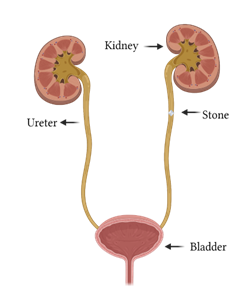Read the article
This article is designed to be distributed to patients. For easy printing, please download the PDF.
Kidney stones, medically known as nephrolithiasis, are characterized by the formation of hard mineral deposits in the kidneys or urinary tract1 (Figure 1). These stones can range in size from a tiny grain of sand to a larger stone that can cause significant pain.
Figure 1: Cartooned urinary tract system with ureteral stone

COMMON RISK FACTORS2
- Inadequate consumption of fluids
- Diet high in salt and animal protein
- Family history of kidney stones
- Gout
- Inflammatory bowel disease
- Hyperparathyroidism
- Previous history of gastric bypass surgery
SYMPTOMS
The symptoms of kidney stones can vary depending on the size and location of the stone. Small stones may not cause noticeable symptoms and can pass through the urinary tract without causing any pain. However, larger stones can cause severe pain from the back to the lower abdomen, nausea, vomiting, and blood in the urine. In some cases, a stone can become lodged in the urinary tract, leading to a urinary tract infection, kidney obstruction leading to impaired function, or even kidney failure.
DIAGNOSIS
Diagnosis of kidney stones usually involves a medical history, comprehensive examination and imaging studies such as an X-ray, ultrasound, or computed tomography (CT) scan.1,2 Urine tests may also be conducted to check for the presence of blood, infection, or other abnormalities. 24-hour urine study and stone analysis can determine the type of stones.
TREATMENT
Treatment for kidney stones is determined based on the size and location of the stone and the severity of symptoms.1 Small stones may pass on their own with the help of increased oral fluid intake, pain medication, and/or prescription medication to relax the ureters. Larger stones greater than 6 mm may require surgical intervention, such as ureteroscopy and stent placement, or a stent placed within the ureter, extracorporeal shock wave lithotripsy (ESWL), or soundwaves that break up the stone, or percutaneous nephrolithotomy (PCNL), which includes catheter placement within the kidney from the flank.3
PREVENTION
Prevention of kidney stones requires following a low-salt diet and drinking plenty of fluids, especially water to maintain a urine output greater than 2 L/day.3 In addition, depending on the type of the kidney stone, certain lifestyle modifications are recommended. For example, avoiding food high in oxalate, such as spinach, rhubarb, and rice bran will decrease the chances of developing calcium oxalate stones, which is the most common type of kidney stones. Increasing the intake of citrus fruits such as lemon, lime, oranges, and grapefruit also prevents certain types of kidney stones. Individuals predisposed to kidney stones due to underlying medical conditions may be prescribed medication to reduce these risks.
SOURCES
- Pearle MS, Goldfarb DS, Assimos DG et al. Medical management of kidney stones. AUA guideline. J Urol. 2014;192:316–324. doi: 10.1016/j.juro.2014.05.006
- Khan S, Pearle M, Robertson W, et al. Kidney stones. Nat Rev Dis Primers. 2016;2:16008. doi: 10.1038/nrdp.2016.8
- Rule AD, Lieske JC, Pais VM. Management of kidney stones in 2020. JAMA. 2020;323(19):1961–1962. doi:10.1001/jama.2020.0662